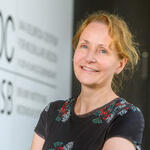Janine Altmüller is new head of the Genomics Platform
Berlin is considered an innovative and attractive research location. “I would like to contribute to this attractiveness,” says Dr. Janine Altmüller. Since July 1 Altmüller, who holds a doctorate in medicine, has headed the joint Genomics Platform of the Berlin Institute of Health (BIH) at Charité – Universitätsmedizin Berlin and the Max Delbrück Center for Molecular Medicine in the Helmholtz Association (MDC). The technology platform is based at the Berlin Institute for Medical Systems Biology (BIMSB) of the MDC in Berlin-Mitte. Two additional laboratories are located at the Berlin-Buch research campus and at Campus Charité Mitte.
Janine Altmüller is bringing together three teams – the Single Cell Technologies Unit headed by Dr. Thomas Conrad, the Next Generation Sequencing (NGS) Unit headed by Dr. Tatiana Borodina, both at the MDC, and the BIH Genomics Core Facility headed by Dr. Tomasz Zemojtel – under the umbrella of the Genomics Platform. “Together we want to provide even better support to users of the technology platform,” says Altmüller. “The three teams are tackling similar questions and using the same equipment to do so.” Now that three small groups have merged to form one large group, it is easier to keep track of the users’ projects, equipment availability, and staff assignments.
Extensive experience from Cologne
Dr. Janine Altmüller, head of the Genomics Platform
Altmüller knows what it takes to set up and run a research platform for genomics. Before joining the MDC, she had headed the NGS Core Facility at the Cologne Center for Genomics (CCG) since 2009. In 2018 the German Research Foundation (DFG) named the CCG the main site of the West German Genome Center (WGGC), a collaboration between the University of Cologne, the University of Bonn and the Heinrich Heine University Düsseldorf. In addition to the illustrious name, the CCG received the finest in next NGS technology: Using state-of-the-art sequencing equipment, Altmüller and her colleagues were able to comprehensively analyze biological samples – from the genome to the epigenome to the transcriptome – and thus create a treasure trove of bioinformatics data that can be used by scientists from a wide range of disciplines. She started in 2008 with a single technician – and in the end had ten lab employees and an annual turnover of €5 million in over 700 research projects.
“I wouldn’t have left the NGS Core Facility in Cologne for any other position in Germany,” says Altmüller. But after more than ten years in Cologne, she says the time is ripe for a new challenge. The task of combining the MDC’s and the BIH’s genomics laboratories into one large but coherent whole is very appealing to her.
Advancing research methods
With the help of a liquid biopsy you can determine which organ is currently secreting a particularly large amount of cell free DNA. This may be a sign that it is experiencing stress.
Altmüller also plans to pursue her own research projects. “I would like to push methods forward that can be used to better answer certain questions in the future and then incorporate the advances into the methods portfolio for our users,” she explains. Along with next generation sequencing methods, these include single-cell technologies. For single-cell analysis, individual cells from tissue samples are placed in a solution, tagged with a barcode and packed into tiny emulsion droplets. The RNA – genetic material that is “read” in the cell – is sequenced and reassigned to its cellular origin. The data obtained allows scientists to precisely infer the function of the cell and thus analyze developmental or disease processes. Another method involves the analysis of cell-free DNA (cfDNA) – extracellular DNA that circulates freely in the blood. Normal body cells but also tumor cells release cfDNA. “With the help of a liquid biopsy – a test where a blood sample is taken instead of doing an invasive tissue biopsy – you can determine which organ is currently secreting a particularly large amount of cfDNA,” explains the scientist. “This may be a sign that it is experiencing stress.” Tumors as well as other acute and chronic diseases can be diagnosed using this method and their progression can be monitored to optimize therapy.
Enthusiastic researcher
Altmüller discovered her enthusiasm for laboratory research after her medical studies, which she completed at RWTH Aachen University. For her doctorate at Humboldt-Universität zu Berlin, she conducted immunohistochemical studies of tumor tissue. At the RWTH University Hospital this enthusiasm developed into a passion for research. Employed as a pediatrician through a third-party funded project led by the senior physician, she spent her nights and weekends toiling away in a small molecular genetics lab. “That’s when I realized that for me research is No. 1, and that being a pediatrician was only the second-best option,” she recalls. So she traded in her stethoscope for a pipette and continued her career as a scientist: first as a postdoc at the Institute of Epidemiology at the GSF Research Center for Environment and Health in Munich; then from 2002 to 2004 at the MDC, where her main task consisted of typing microsatellites – non-coding DNA sequences – in Professor Peter Nürnberg’s lab; and after that at the CCG in Cologne.

So now it’s back to Berlin. “The teams at the MDC and the BIH are excellently equipped in terms of both personnel and technology,” says Altmüller. “You can really make things happen here. I can’t wait to get started.”
Text: Jana Ehrhardt-Joswig







